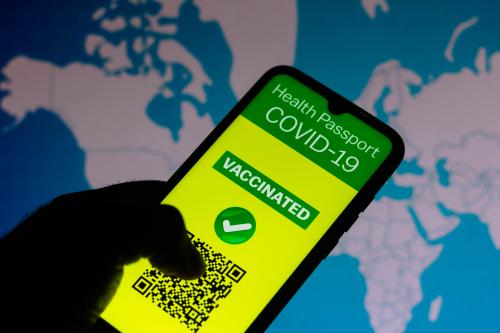COVID-19 pandemic fatigue has many people seeking a return to normalcy. But health care needs a new normal—one that achieves better health outcomes for more people. Wishing for a return to health care’s old normal is like driving into a long tunnel hoping for a U-turn that takes you back to where you started.
An Imperative for Change
Multiple studies have shown that the U.S. spends more per capita on health care than any country in the world, yet it ranks poorly on health care access and outcomes compared to other high-income countries. Clearly, progress is needed so that more people can achieve better health.
Value-based health care starts from the perspective that the purpose of health care is to help individuals and families achieve better health. Health care value—the improvement in outcomes achieved for the money spent—is created when care improves a person’s health, and value is increased when that improvement is achieved less expensively.
One avenue to better health results is expanding use of tools like telehealth and, more broadly, digital health, provided that their adoption focuses on improving health outcomes rather than simply enabling more appointments. This is the essence of the shift in perspective from volume to value. It’s moving beyond asking how to create more health care (more volume) to asking how to achieve better health outcomes for the money spent (more value).
Accordingly, the key question for the adoption of any of the many modalities comprising digital health is whether they will help patients achieve better health. For example, do digital health services increase value for the people being served? This is often a challenging question to answer because meaningful outcomes of health care are not usually measured and reported. Instead, measurement focuses on health care processes (e.g., whether or not patients with diabetes received foot exams) and volume of services delivered (e.g., the number of tests or procedures performed). One problem with this focus is that process measurement supports the mindset of “more is better.” In order to know if health care is working, measurement needs to go beyond tracking what was done to asking what were the results. A second problem is the assumption that a good process guarantees good outcomes. That correlation is far from inevitable. Indeed, the Commonwealth Fund’s recent comparison of 11 high-income countries found the U.S. performed worst in health care spending, access, and outcomes while ranking second-best on measures of care process.
Measuring the outcomes of digital health innovations will also provide critical insight about when, how, and for whom the innovation works best. Health care includes many different services, addressing a wide array of health issues, for people living in varied circumstances. It makes no sense to assume that any innovation will be equally effective across all of these. Instead, those who are implementing and studying the use of digital health innovations need to be vigilant about asking what is driving the successes and the failures. In particular, implementors need to ask if the innovation is reducing, maintaining, or (worst of all) widening the economic and racial disparities that are endemic in the in-person care delivery system.
Create New Solutions and Strengthen Relationships—Beyond Digitizing Existing Care
The pandemic’s disruptions create a moment to fundamentally rethink health care. Rather than simply replicating in-person care virtually, how can care be transformed to deliver dramatically better outcomes for patients? Digital health can be used to improve health care results and health equity by creating better solutions for people who face challenges in access and/or in achieving better health outcomes. Doing so requires understanding the needs and goals of people who are not well-served by today’s care.
Value-based care starts with work to identify the shared needs and common goals of a group of people for whom health outcomes could be better. For example, people struggling to manage diabetes, and who work in rotating shift jobs, share both medical and social circumstances. New solutions can address these patients’ needs with care that works in their lives and that is designed to achieve diabetes remission rather than to follow disease progression. Addressing shared needs enables specific solutions with team-based, relationship-centered health care instead of poorly-coordinated treatments. Digital health can be used in these solutions where it adds to the efficacy and efficiency of care delivery, and in situations where it can interrupt patterns of health and care disparities.
However, some researchers and practitioners bemoan digital health and virtual communication as less effective, impersonal alternatives to in-person visits. In reality, virtual care can tighten relationships by enabling people to be closer in touch and communicate more frequently and conveniently, even across wide distances. Digital health can also be used to strengthen relationships between individuals and their care team, as well as among care team members.
Digital health also makes it possible for care teams to include national experts. While today’s care relies on local expertise and results in tremendous unwarranted variation, the new normal can enable state-of-the-art medical knowledge to be delivered locally for the patient. Payment models can include doctor-to-doctor consults that reduce disparities in care for patients, particularly in rural or economically-disadvantaged locations where physician shortages make it difficult or impossible to staff an in-person multidisciplinary team. Project ECHO is one example of this approach and has contributed measurably to better health outcomes in several contexts.
Payment
It remains to be seen whether payments for digital health will continue after the pandemic, or if the telehealth genie will somehow be jammed back into the bottle. Like other tools, digital health offerings are a means to the end of improving health. Rather than telling clinical teams when they may use them, policymakers and administrators could allow clinicians and patients to choose.
A problem, once again, is that health outcomes often aren’t measured, so it is difficult to know if a new approach is better—or frankly which aspects of current care are working well at all. For this reason, one of the most significant enablers of digital health care innovations is widespread participation in outcome measurement. This may mean requiring clinicians to measure patients’ outcomes and participate in registries or other reporting mechanisms.
A Portal to Higher-Value Care
The pandemic continues to interrupt, constrain, and end many lives. Its impacts on individuals, families, clinicians, and communities will reverberate long into the future. For people and organizations delivering care, the accepted normal has been disrupted. As Suzanna Arundhati Roy observes, this break can serve as a gateway to transformational change if we are willing to fight for it. Better health and health equity are worth the fight.
“Historically, pandemics have forced humans to break with the past and imagine their world anew. This one is no different. It is a portal, a gateway between one world and the next. We can choose to walk through it, dragging the carcasses of our prejudice and hatred, our avarice, our data banks and dead ideas, our dead rivers and smoky skies behind us. Or we can walk through lightly, with little luggage, ready to imagine another world. And ready to fight for it.” —Suzanna Arundhati Roy
-
Acknowledgements and disclosures
The authors thank Steven Andrews, PhD for his assistance with this article.









Commentary
Using digital health to improve health outcomes and equity
October 5, 2021